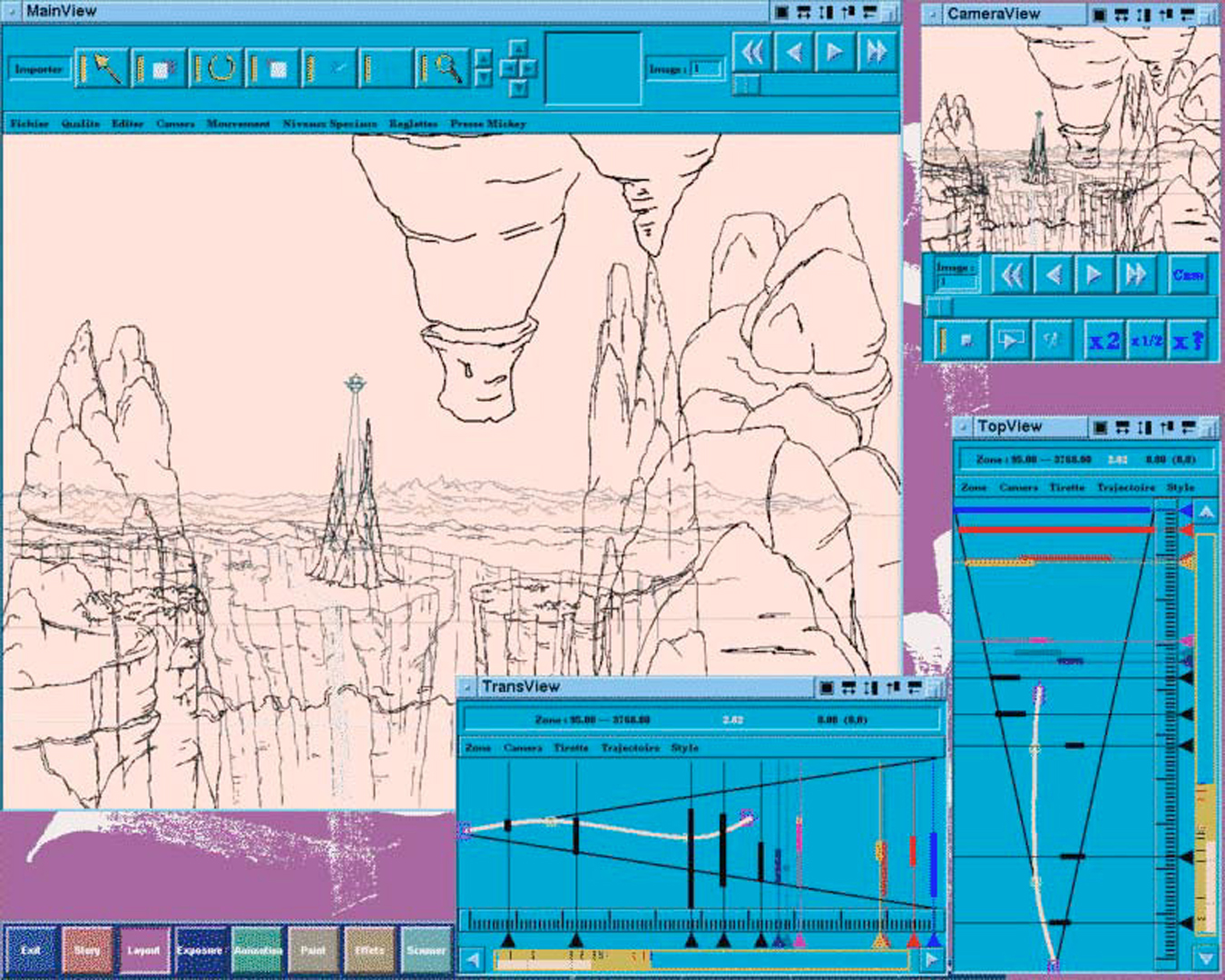“TicTacToon: a paperless system for professional 2D animation” by Fekete, Bizouarn, Cournarie, Galas and Taillefer
Conference:
Type(s):
Title:
- TicTacToon: a paperless system for professional 2D animation
Presenter(s)/Author(s):
Abstract:
TicTacToon is a system for professional 2D animation studios that replaces the traditional paper-based production process. TicTacToon is the first animation system to use vector-based sketching and painting: it uses an original method to transform a pen trajectory with varying pressure into a stroke of varying thickness, in realtime. TicTacToon provides resolution independence, a virtually infinite number of layers, the ability to dynamically manage perspective and sophisticated support for reuse of drawings. Other innovations include replacement of the rostrum model with a 3D model and integration into the overall 2D animation production process. TicTacToon is in daily use by 2D animation studios for a wide range of productions, from commercials to television series and even a feature film. The user interface enables professionals to sketch and draw as they do on paper. Over 100 professional animators have used the system over a period of two years and most need less than an hour before beginning productive work. TicTacToon eliminates most tedious tasks and frees professional animators for more creative work.
References:
1. Adobe Systems Incorporated. PostScriptLanguage Reference Manual. Addison-Wesley, Reading, MA, USA, second edition, 1990.]]
2. Adobe Systems Incorporated, 1585 Charleston Road, E O. Box 7900, Mountain View, CA 94039-7900, USA, Tel: (415) 961-4400. Adobe Premiere 1.0 User Guide, 1993.]]
3. D. Austin Henderson, Jr. and Stuart K. Card. Rooms: The Use of Multiple Virtual Workspaces to Reduce Space Contention in a Window-Based Graphical User Interface. TOGS, 5(3):211-243, 1986.]]
4. Thomas Baudel. A Mark-Based Interaction Paradigm for Free-Hand Drawing. In Proceedings of the ACM SIGGRAPH Symposium on User Intelface Software and Technology, Marina del Rey, 1994. ACM.]]
5. Nathaniel S. Borenstein and Ned Freed. MIME (Multipurpose Internet Mail Extension): Mechanism for Specifying and Describing the Format of Internet Message Bodies. Request for Comments: 1341, June 1992.]]
6. N. Burtnyk and M. Wein. Interactive Skeleton Techniques for Enhancing Motion Dynamics in Key Frame Animation. Communications of the ACM, 19:564-569, 1976.]]
7. Cambridge Animation. The Animo System.]]
8. Edwin E. Catmull. A hidden-surface algorithm with antialiasing. Computer Graphics (SIGGRAPH ’78 Proceedings), 12(3):6-11, August 1978.]]
9. Edwin E. Catmull. The problems of computer-assisted animation. Computer Graphics (SIGGRAPH ’78 Proceedings), 12(3):348-353, August 1978.]]
10. Charles X. Durand. The “TOON” project: requirements for a computerized 2D animation system. Computers and Graphics, 15(2):285-293, 1991.]]
11. Jean-Daniel Fekete. A Multi-Layer Graphic Model for Building Interactive Graphical Applications. In Proceedings of Graphics Intelface ’92, pages 294-300, May 1992.]]
12. Paula Ferguson. The Xll Input Extension: Reference Pages. The X Resource, 4(1):195-270, December 1992.]]
13. James D. Foley, Andries van Dam, Steven K. Feiner, and John F. Hughes. Fundamentals of Interactive Computer Graphics. Addison-Wesley Publishing Company, second edition, 1990.]]
14. Michel Gangnet, Jean-Claude Herv6, Thierry Pudet, and Jean- Manuel Van Thong. Incremental Computation of Planar Maps. In Jeffrey Lane, editor, Computer Graphics (SIGGRAPH ’89 Proceedings), volume 23, pages 345-354, July 1989.]]
15. Michel Gangnet, Jean-Manuel Van Thong, and Jean-Daniel Fekete. Automated Gap Closing for Freehand Drawing. {Technical Sketch} Siggraph’94, Orlando, 1994.]]
16. Jakob Gonczarowski. A Fast Approach to Auto-tracing (with Parametric Cubics). In Robert A. Morris and Jacques Andr6, editors, Raster Imaging and Digital Typography III Papers from the second RIDT meeting, hem in Boston, Oct. 14- 16,1991, pages 1-15, New York, 1991. Cambridge University Press.]]
17. Claude Huhardeaux. The Label 35 System. Personal Communication, 1989.]]
18. Mark Levoy. A Color Animation System Based on the Multiplane Technique. In Computer Graphics (SIGGRAPH ’77 Proceedings), volume 11, pages 65-71, Summer 1977.]]
19. Mark Levoy. Area Flooding Algorithms. In Two-Dimensional Computer Animation, Course Notes 9 for SIGGRAPH 82. ACM Press, New York, NY 10036, USA, July 1982.]]
20. Mark A. Linton, John M. Vlissides, and Paul R. Calder. Composing user interfaces with InterViews. IEEE Computer, 22(2):8-22, February 1989.]]
21. Microsoft Corporation. SoftImage Toonz Feature Summary. Part No. 098-58493, One Microsoft Way, Redmond, WA 98052-6399, 1995.]]
22. Bill Perkins. The Creative Toonz System. Personal Communication, 1994.]]
23. Michael Plass and Maureen Stone. Curve Fitting with Piecewise Parametric Cubics. Computer Graphics (SIGGRAPH ’83 Proceedings), 17(3):229-239, July 1983.]]
24. Thomas Porter and Tom Duff. Compositing Digital Images. In Hank Christiansen, editor, Computer Graphics (SIGGRAPH ’84 Proceedings), volume 18, pages 253-259, July 1984.]]
25. Richard L. Potter, Linda J. Weldon, and Ben Shneiderman. Improving the Accuracy of Touch Screens: an Experimental Evaluation of Three Strategies. In Proceedings of ACM CHI’ 88 Conference on Human Factors in Computing Systems, pages 27-32, Washington, DC, 1988.]]
26. Thierry Pudet. Real Time Fitting of Hand-Sketched Pressure Brushstrokes. In Eurographics’94. Proceedings of the European Computer Graphics Conference and Exhibition, Amsterdam, Netherlands, 1994. North-Holland.]]
27. Barbara Robertson. Digital Toons. Computer Graphics WorM, pages 40-46, July 1994.]]
28. Barbara Robertson. Disney Lets CAPS Out of the Bag. Computer Graphics WorM, pages 58-64, July 1994.]]
29. Robert W. Scheifler and Jim Gettys. The X Window System. ACM Transactions on Graphics, 5(2):79-109, 1986.]]
30. Philip J. Schneider. An Algorithm for Automatically Fitting Digitized Curves. In Andrew S. Glassner, editor, Graphics Gems I, pages 612-626,797-807. Academic Press, 1990.]]
31. Thomas W. Sederberg, Peisheng Gao, Guojin Wang, and Hong Mu. 2D Shape Blending: An Intrinsic Solution to the Vertex Path Problem. In James T. Kajiya, editor, Computer Graphics (SIGGRAPH ’93 Proceedings), volume 27, pages 15-18, August 1993.]]
32. Michael A. Shantsis. A Model for Efficient and Flexible Image Computing. In Andrew Glassner, editor, Proceedings of SIGGRAPH ’94 (Orlando, Florida, July 24-29, 1994), Computer Graphics Proceedings, Annual Conference Series, pages 147-154. ACM SIGGRAPH, ACM Press, July 1994. ISBN 0- 89791-667-0.]]
33. Peter Van Sommers. Drawing and Cognition. Cambridge University Press, Cambridge, 1984.]]
34. Jean-Michel Spiner. PEGS Technical Description VI.00, 1994.]]
35. Bruce A. Wallace. Merging and transformation of raster images for cartoon animation. Computer Graphics (SIGGRAPH ’81 Proceedings), 15(3):253-262, August 1981.]]





